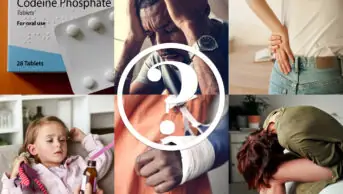
Shutterstock.com
Many people suffer from some form of pain. Data from 2011 show around 100 million adults living with a common chronic pain condition in the United States[1]
, exceeding the number of patients with cancer, diabetes and heart disease combined[2]
. According to the Centers for Disease Control and Prevention (CDC) — the national public health institute of the United States — by 2014 nearly 2 million people either misused or were dependent on prescription opioids[3]
.
As of 2011, 75% of the world’s opioid prescriptions were prescribed in the United States, a country that makes up less than 5% of the world’s population[4]
. However, opioid abuse is not exclusive to the United States. Many other western countries now face an increasing number of people battling opioid addiction[5]
. For example, in Europe, 5% of all patients entering drug treatment programmes in 2011 reported prescription opioids as their illicit drug of choice[6]
.
There are many reasons why the prescription of opioid painkillers has increased, leading to a rise in addiction[7]
. In the 1990s, advocacy groups and pain specialists suggested that the United States was suffering from an epidemic of untreated pain. There was an increased push in marketing for opioid painkillers, such as oxycodone, by pharmaceutical companies, which led to increased production and sales of opioid painkillers. In fact, oxycodone and hydrocodone are among the most prescribed medicines in the United States.
Amid a growing concern for patients becoming addicted to opioid painkillers, guidelines in the United States have been issued to discourage doctors from prescribing opioid painkillers, recommending that pain should not be managed by official quality measures, such as pain scores. But patients in genuine pain, particularly those with chronic pain, still require treatment. As such, we need to reassess how we measure pain rather than discard official measures of pain completely.
Not just a number
The CDC guideline recommends that healthcare professionals should ask patients if they enjoy their life as well as how severe their pain is[8]
and is advising doctors against prescribing opioids to treat chronic pain[9]
.
There has been great progress in how pain is assessed, treated, and understood. There are four vital signs that medical professionals routinely monitor: body temperature, pulse rate, respiration rate, and blood pressure, and in the early 1990s, it was suggested that pain should be regarded as the fifth vital sign[10]
. As a result, to assess how much pain impacts recovery in hospitals, we began to ask patients their ‘pain score’. At the time, pain assessments and the addition of the fifth vital sign was a major milestone in the history of medicine. The pain score was praised for opening lines of communication in situations where patients may not be able to communicate their feelings of pain effectively to their healthcare provider. The approach provided a conduit to assess pain when there was no other option to assess. But unfortunately, pain is uniquely subjective and can be distorted. Even though we know that pain is inevitable, especially after surgery or when admitted to hospital after trauma, it is often used to determine general patient satisfaction in hospitals[11]
.
Unlike blood pressure, heart rate and other critical vital signs, we do not have a monitor, device or better way to assess pain other than asking a patient what their pain score is. And while a score could be useful to gauge the level of treatment required, we should consider that patients may not be able to fully describe the extent of their pain. Similarly, pain scores will undoubtedly vary from person to person.
Earlier this year, the American Medical Association suggested removing pain as a fifth vital sign to allow physicians to treat patients without the pressure of prescribing powerful opioids[12]
. A discussion with patients suffering from chronic pain and their families and/or carers should help to uncover that a pain score does not go far enough. We need to ask much more than this to allow for better pain care.
Dependence and addiction
Many physicians have decided not to prescribe opioids at all. In fact, many of my colleagues want to rescind their ability to prescribe opioids from the Drug Enforcement Administration — a United States federal law enforcement agency under the US Department of Justice — so that the question whether to prescribe or not cannot arise.
However, this could mean that patients suffering from genuine pain who require or want treatment are stigmatised and labelled as potential drug misusers, resulting from their physician’s fear to prescribe opioid painkillers[13]
. As a result, they may be less likely to get access to the right treatment plan for their pain. Prescribers need to know that they have certainly been part of the problem but they can also be the solution.
As part of this solution, we need to have more meaningful conversations with patients with chronic pain, opioid addiction, or both. The most important tool for addressing addiction is communication — patients should be encouraged to be open with their healthcare providers and work with them on an effective pain management plan. Physicians should be clear about the risks of addiction and this will allow them to address any warning signs promptly. For example, patients experiencing cravings for their medicines along with symptoms like mood changes, difficulty sleeping, oversensitivity to stimuli and increased blood pressure may be exhibiting signs of dependence that has transitioned into abuse.
Importantly, patients need to understand that they do not need to have an opioid addiction to be at risk of an overdose. For example, if a patient takes a benzodiazepine (such as alprazolam) or a hypnotic (such as zolpidem) and they misuse other substances, like heroin, marijuana or alcohol, the combination can have deadly consequences. Any drug that slows down breathing increases these risks. People with kidney or liver disease are also at high risk of complications because their body may not break down the opioids the way it should.
However, when opioids are taken to manage pain as prescribed, overdose is unlikely. Through counselling and consultations, physicians and pharmacists can ensure that patients know how to use opioid medicines safely and responsibly. In this way only can pain be treated effectively. Problems occur when people begin taking more tablets than prescribed, or when they take them more often than recommended. The risk of overdose also increases when patients take the drugs for reasons other than pain relief — to help them sleep, for instance, or to self medicate anxiety or depression.
It is also important to ensure that carers of patients taking opioid painkillers are counselled about the warning signs of an overdose. If a person’s breathing slows down, for example, or pupils become small, or lips or fingernails develop a bluish tint, or skin becomes pale and clammy — these are signs of a possible overdose[14]
. In this event, carers should call emergency services immediately or, if available, administer naloxone — an opioid antagonist that temporarily reverses the effects of opioids for 20 to 30 minutes.
In July 2016, the United States Congress passed the Comprehensive Addiction and Recovery Act, a bipartisan legislation that will allow for more education research, treatment and funding for opioid addiction[15]
. But this is not enough. We need to focus on solutions rather than the problems. We need to find a better way to assess pain before the fifth vital sign is no longer used. We also need to ensure that those in pain are looked after while we try to curb the growing addiction problem.
Anita Gupta is vice-chair and associate professor at Drexel University College of Medicine in Philadelphia, Pennsylvania, United States. She is an anaesthesiologist, pain specialist and pharmacist and is currently co-chair of the American Society of Anesthesiology Committee on Opioid Abuse and an adviser to the US Food and Drug Administration.
References
[1] Institute of Medicine report from the committee on advancing pain research, care, and education: relieving pain in America, a blueprint for transforming prevention, care, education and research. The National Academies Press, 2011. Available at: http://books.edu/openbook.php?record_id=13172&page=1 (accessed 19 August 2016).
[2] Simon LS. Relieving pain in America: a blueprint for transforming prevention, care, education, and research. Journal of Pain & Palliative Care Pharmacotherapy 2012;26;197–198. doi: 10.3109/15360288.2012.678473
[3] Substance Abuse and Mental Health Services Administration, National Survey on Drug Use and Health, 2014. Available at: http://www.samhsa.gov/data/sites/default/files/NSDUH-FRR1-2014/NSDUH-FRR1-2014.pdf.
[4] Centers for Disease Control and Prevention. Why guidelines for primary care providers? Available at: https://www.cdc.gov/drugoverdose/pdf/guideline_infographic-a.pdf (accessed 19 August 2016).
[5] Giraudon I, Lowitz K, Dargan PI et al. Prescription opioid abuse in the UK. Br J Clin Pharmacol 2013;76:823–824. doi: 10.1111/bcp.12133
[6] Degenhardt L & Hall W. Extent of illicit drug use and dependence, and their contribution to the global burden of disease. The Lancet 2012;379:55–70. doi: 10.1016/S0140-6736(11)61138-0
[7] Lyapustina T & Alexander GC. The prescription opioid addiction and abuse epidemic: how it happened and what we can do about it. The Pharmaceutical Journal 2015;294:627. doi: 10.1211/PJ.2015.20068579
[8] CDC Guideline for Prescribing Opioids for Chronic Pain. Available at: http://www.cdc.gov/drugoverdose/prescribing/guideline.html.
[9] Zalkind S. CDC issues guidelines against opioid prescriptions to treat chronic pain. The Guardian 17 March 2016. Available at: https://www.theguardian.com/us-news/2016/mar/17/cdc-guidelines-against-prescribing-opioids.
[10] American Pain Society. Assessment of Pain. Available at: http://americanpainsociety.org/uploads/education/section_2.pdf (accessed 19 August 2016).
[11] Hoffman A & Tavernise S. Vexing question on Patient Surveys: Did We Ease Your Pain? New York Times 4 August 2016. Available at: http://www.nytimes.com/2016/08/05/health/pain-treatment-hospitals-emergency-rooms-surveys.html?rref=collection%2Fsectioncollection%2Fhealth.
[12] AMA Advocacy Update. 23 June 2016. Available at: http://www.ama-assn.org/sub/advocacy-update/2016-06-23.html.
[13] Span P. New Opioid Limits Challenge the Most Pain-Prone. The New York Times 6 June 2016. Available at: http://www.nytimes.com/2016/06/07/health/opioid-limits-older-patients-pain.html (accessed 19 August 2016).
[14] World Health Organization. Information sheet on opioid overdose. November 2014. Available at: http://www.who.int/substance_abuse/information-sheet/en/.
[15] S.524 - Comprehensive Addiction and Recovery Act of 2016. Available at: https://www.congress.gov/bill/114th-congress/senate-bill/524/text.


